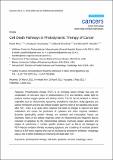Cell Death Pathways in Photodynamic Therapy of Cancer
Author(s)
Mroz, Pawel; Yaroslavsky, Anastasia; Kharkwal, Gitika B.; Hamblin, Michael R.
DownloadMroz-2011-Cell death pathways.pdf (654.5Kb)
PUBLISHER_CC
Publisher with Creative Commons License
Creative Commons Attribution
Terms of use
Metadata
Show full item recordAbstract
Photodynamic therapy (PDT) is an emerging cancer therapy that uses the combination of non-toxic dyes or photosensitizers (PS) and harmless visible light to produce reactive oxygen species and destroy tumors. The PS can be localized in various organelles such as mitochondria, lysosomes, endoplasmic reticulum, Golgi apparatus and plasma membranes and this sub-cellular location governs much of the signaling that occurs after PDT. There is an acute stress response that leads to changes in calcium and lipid metabolism and causes the production of cytokines and stress response mediators. Enzymes (particularly protein kinases) are activated and transcription factors are expressed. Many of the cellular responses center on mitochondria and frequently lead to induction of apoptosis by the mitochondrial pathway involving caspase activation and release of cytochrome c. Certain specific proteins (such as Bcl-2) are damaged by PDT-induced oxidation thereby increasing apoptosis, and a build-up of oxidized proteins leads to an ER-stress response that may be increased by proteasome inhibition. Autophagy plays a role in either inhibiting or enhancing cell death after PDT.
Date issued
2011-06Department
Harvard University--MIT Division of Health Sciences and TechnologyJournal
Cancers
Publisher
MDPI AG
Citation
Mroz, Pawel, Anastasia Yaroslavsky, Gitika B Kharkwal, and Michael R. Hamblin. “Cell Death Pathways in Photodynamic Therapy of Cancer.” Cancers 3, no. 4 (June 3, 2011): 2516–2539.
Version: Final published version
ISSN
2072-6694